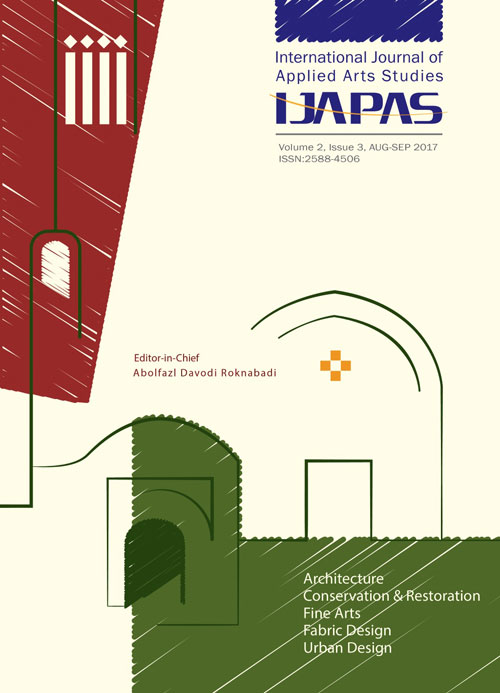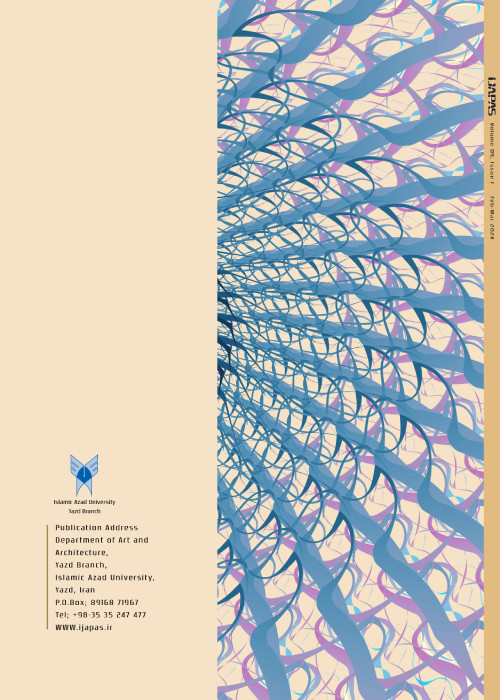فهرست مطالب

International Journal of Applied Arts Studies
Volume:2 Issue: 3, Aug-Sep 2017
- تاریخ انتشار: 1396/06/11
- تعداد عناوین: 6
-
Pages 7-20Reducing the energy consumption of the buildings in Iran is essential, since the building energy consumptions in the country are about 40% of the total energy consumption. Approaches and strategies to reduce the level of energy consumption in buildings can be investigated in two main parts: designing energy-efficient buildings and energy efficiency in existing buildings. With the advent of various technologies, complexity and administration costs are also increased. Therefore, the decision-making about the selection of optimal strategies and finding the solutions to reduce the energy consumption in buildings has become more important. On the other hand, the interaction between the design elements, climate, users, cooling, heating, ventilation, and lighting is very complex and can only be studied by simulating all of the influencing factors in the energy efficiency of the building. Since the building shell as the separator of the interior and exterior environment plays an important role in the thermal behavior of the buildings, in this article, the use of double skin facades was investigated, as a new technology that is designed as an obstruction which creates a balance between the interior and exterior environments. Based on the results of this study, it was concluded that if this technology is properly used and implemented in the designing process of the buildings, it could have an important role in reducing the energy consumption of buildings, as well as several side benefits.Keywords: Double Skin Facade, Energy, Saving, Optimization
-
Pages 21-30One of the most significant issues in architectural design is to take into account the users’ needs, particularly social interactions, which in turn lead to individual growth. Weakness in expressing social interactions in designing a space is among the principle issues in today’s architecture. In fact, what was not infrequent long ago, in old religious and cultural constructions of Iran, such as mosques and other religious building, was the manifestation of people interactions and relations in the body of the constructions. Based on the observations, nowadays the individuals seem to be estranged from these spaces. This leads to a lack of fascination on the users and thus a gradual decrease in the quality of the spaces. The primary purpose of the current research is to explain the criteria of designing a religious and cultural complex, the aim of which is to increase social interaction among users. This research uses library studies, and descriptive-analytic research method. The social and physical solutions that are deduced from this research are to create the affiliation, security, public participation, accessibility, cordiality, as well as creating public and collective spaces, using climate-appropriate natural elements, and variety in form and robustness.Keywords: Social Interactions, Religious-Cultural, Complex, Architecture
-
Pages 31-44In recent decades the unprecedented growth of urbanization, which has been the result of economic and industrial growth, has led to the expansion of cities. Some of the villages located away from the city, within the urban texture, the surrounding land which is considered more evolving as the urban development axes in the metropolitan plans. One of the most noticeable and disturbing issues in these areas is the mismatch problem between the new built environment around the countryside and the immediate urban fabric, which has a significant impact on the quality of urban living. This research aims at evaluating and ranking the quality of life indicators, based on the TOPSIS technique, by exploring the Naimeabad neighborhood of Yazd city, which has a rustic nucleus located in the heart of the city. The study implemented descriptive-analytical method for data collection and analysis. The library data were collected using questionnaires and field surveys. Sample population was selected using simple random sampling method. Cronbach’s alpha was used for 288 sample selections and confirmed the reliability of the questionnaire. In addition, the information obtained from the questionnaire was analyzed and ranked using the TOPSIS technique. The research results shows that the social dimension gained the best points and the economic dimension gained the lowest.Keywords: Quality of Life, Rural Texture, Naimeabad Yazd, TOPSIS Technique
-
Pages 45-56This study tries to present a crisis management plan for the Persepolis World Heritage Site (a case study about drought). The study and data collection procedure is conducted mainly by descriptive and analytical methods. The study population includes the experts of historical places in Department of Agriculture, Natural Resources Department, Geology Department, and Regional Water Department of Fars, among whom 62 people were chosen by using Cochran sampling formula. Their liability for the case study variable of drought was confirmed to be 83 percent, using Cronbach alpha. In this study, the internal and external factors of weaknesses, strengths, threats, and opportunities in this important World Heritage Site were investigated using SPSS software and SWOT method. In this way, drawing a matrix (SWOT) and implementing related strategic analysis, a strategy table including WO, ST, SO, WT has been provided regarding proactive protection. As the next step, putting collective wisdom and consensus of experts and managers of the department were proposed to optimize the designed strategies, to prioritize these strategies, and finally to choose the most suitable one for the aforementioned site.Keywords: Crisis, Drought, Persepolis, Correct Pattern, Management
-
Pages 57-70The city of Yazd had one of its most historically prosperous periods in the time of “āl-e-Muzaffar” dynasty, in the 8th century. In this period, various monuments and buildings were built, one of which was the tomb of “Seyyed Shams-o-ddin” in Yazd. This monument was previously a complex of “khanqah” (Sufis’ worship place), “madrasah”, (traditional school), “bazaar” (traditional enclosed marketplace), “āb-anbār” (traditional reservoir), and historical bathroom. By the support of Seyyed Shams-o-ddin, the plan of this building was designed in the city of Tabriz and was sent to Yazd to be built. After Seyed Shams-o-ddin’s death, this building turned into his tomb. In addition to its architecture, the decorations of this tomb are samples of the most accurate and various-pattern ornaments of the Ilkhanid period, created in the forms of tilings, paintings, and plasterworks. Through field and library studies, this article presents a case study about motifs and arrays of Seyed Sham-o-ddin tomb and compares them with the ornaments of Soltaniyeh dome in the city of Zanjan. Then through historical and descriptive method, different characteristics of these ornaments are analyzed. In general, this research shows that the decorations of Ilkhanid period have an independent and unique style. They were expanded in a vast geographic area and then were taken to other areas as well. In terms of technique and design, the decorations of Seyed Sham-o-ddin tomb, is in continuation of the Ilkanid style, especially those related to the Soltaniyeh dome.Keywords: Decorative Motifs, Yazd Architecture, Seyed Shams-o-ddin Tomb, Soltanieh Dome
-
Pages 71-78In the present era, neglect of basic skills and updated technologies in the field of art has decreased progress and performance. That's why superior technologies can play a vital role in the development of art. Laser is one of the technologies used to cut a variety of materials, including textile. Laser has sufficient power, precision, and high speed through the accumulation of energy and motion in a straight line. One of the applied arts in the field of textile design is the art of cloth making. In this article, textile fabrics are made by lasers in order to enhance the precision and speed, as far as the efficiency and quality of work can be promoted. Moreover, in art section, abstract art is used in order to create designs on fabrics, and abstract designs are provided using laser. Eventually, clothes were produced using abstract designs, and with the help of laser and textile making.Keywords: Textile Making, Abstract Arts, Laser, Clothes Design


